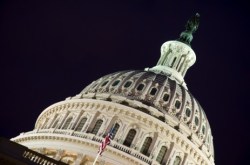 The Washington Post‘s Charles Lane has a column today in which he argues that the Obama administration’s efforts to bolster clean energy is money “wasted,” and that if government does “double down on clean energy, it’s the federal budget that will end up busted.”
The Washington Post‘s Charles Lane has a column today in which he argues that the Obama administration’s efforts to bolster clean energy is money “wasted,” and that if government does “double down on clean energy, it’s the federal budget that will end up busted.”
He’s wrong.
Lane bases his arguments largely on a report released earlier this month by Brookings. “Clean Energy: Revisiting the Challenges of Industrial Policy” assesses the value of subsidies in bolstering a clean energy economy.
What Brookings found probably won’t come as much of a surprise: Subsidizing clean energy initiatives is not always effective and is not the ideal way to bolster the sector. Instead of subsidies, the most market-efficient way to support clean energy is to internalize the costs of fossil fuel-based energy production. In other words, to build a system that — among other things — ends the ability of coal power producers to emit carbon dioxide and other pollutants into the atmosphere where they will produce long-term costs in global warming and negative health impacts.
We tried this one way; it was called cap-and-trade. It was proposed by Republicans, then killed when Democrats began to champion it. Politically, it’s a non-starter.
There’s another way to do it: regulation. The EPA has issued several rules that would lower the allowable baseline for fossil fuel pollution. This is the sort of reception such efforts receive.
Which is why the fossil fuel industry and its allies focus on subsidies as a target. Subsidies are the primary support the government provides to clean energy. If you remove subsidies for clean energy projects, it’s almost impossible for them to get a foothold in a crowded marketplace — even if, over the long run, the technology will obviously be dominant and more cost-effective. If you came up with a new retail system, one that held real promise to vastly improve the consumer experience, how do you think you’d do if Walmart wanted to take you out?
But, as yesterday’s Twitterstorm noted, subsidies don’t only go to clean energy companies. Here’s a graphic from the Brookings report that shows where subsidies for research and development have gone over the past 40 years.
See that spike in the second small graph? Fossil fuels received far more research and development subsidies during the second big spike than did clean energy projects. Imagine if your little store was trying to compete with Walmart and the government was giving Walmart far more money than you.
Subsidies for clean energy may not be the most efficient. But if we want to position the United States as a leader in the emerging clean energy sector, we can’t let existing energy systems both kill research and development for clean energy and block attempts to internalize their own costs. Or, at the very least, we should maybe give them less money to do so.
The Post’s Lane doesn’t broach the subject of fossil fuel subsidies; presumably, in his eyes, throwing government money at the feet of some of the world’s wealthiest companies to do research is a perfectly sensible investment. As for cleantech?
Having China or someone else develop clean-energy technology might be to U.S. advantage; let them pay the inevitable start-up costs; then we can adapt the discoveries to our own needs.
Lane suggests we just play catch-up.
Now that’s a smart investment strategy.




